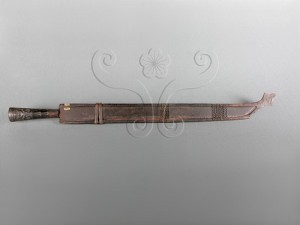TELDAP Collections
| Knives (佩刀) |
|
Introduction There are two main types of knives among the Paiwan tribe, one for ceremonial use and the other for work. Work knives were undecorated. Each Paiwan male carried a knife as a weapon for defense, obtaining firewood, cutting up animals for food and producing tools. The handle of the knife was hollow for attaching a long wooden or bamboo rod to create a hunting spear. Ceremonial knives were more refined, especially those of the noble class. They were often decorated with carved patterns of disembodied human heads and hundred-pace snakes, inlaid shell or metal pieces and lacquer. Some knife sheaths had a woven strap attached for carrying the knife at the waist and as decoration. In the past, ceremonial knives were the exclusive property of males of the noble class. When not in use, they were hung in a position of honor next to the main post in the home. During important occasions, such as celebrations and ceremonies or important negotiations, this type of knife was worn at the side. In addition to displaying the social position of the wearer, it was a symbol of prestige and bravery.
Knives are generally referred to as Takit in RAVAL society. Due to different uses, different types of knives were produced. They include Vinirlian (double-edged metal blade), Ginagalan (carved knife of the nobility) and Dinaluman (knife used by the common class). Vinirlian refers to a double-edged knife and is considered the most valuable of the three types. It is also known as a bronze knife, one of the three cultural treasures of the Paiwan tribe. Ginagalan refers to the carved knives used by the males of the noble class. Dinaluman refers to the knives used by the males of the common class. Usually work knives were simply called Takit. Takit refers to a straight knife. Work knives with a curved metal blade, such as sickles, were called Givaguvagu.
Although the blade is usually obtained through purchase, it may require some slight modification or reconditioning. The knife handle and sheath are usually made from the hard wood of the Guzumai tree. If the knife handle is made from metal, rattan is used to bind it to the knife. To produce the knife sheath, wood with a certain degree of curvature is selected. On the front of the sheath a concave trough is created for placing a protective talisman. Then, patterns are carved, such as disembodied human heads, human figures and hundred-pace snakes, or the sheath is covered in lacquer. Sometimes, a hole is made in the sheath near the handle for attaching a rope, for hanging the knife when not in use. Or, a woven strap is tied to the sheath for carrying the knife at the waist and to enhance its decorative beauty. Methods of use A knife was an essential daily use item for every Paiwan male. It was also an important accessory on occasions when formal attire was worn. A knife was usually worn at the waist on the left side, and was both practical and symbolic. The Ginagalan (carved knife of the nobility) and the Dinaluman (knife used by the common class) are collectively referred to as Takit. During weddings of the nobility, Ginagalan was an essential betrothal gift. On the fifth day of the Harvest Festival of RAVAL, coming-of-age rites were held. Males were presented with a knife, either Ginagalan or Dinaluman, based on the class to which they belong. Females were presented with earrings. The receiving of these items symbolized entry into adulthood. On the same day, the males of the village gathered to carry out divination rites. During these divination rites, the men used their knives to clear away the weeds along a mountain path. There are some taboos related to Paiwan knives. For example, females are not allowed to touch or step over a knife. Even the clothing of a female must not come in contact with a knife. This taboo includes girls as well as women. In addition, during the period of mourning, any family members of the deceased must not touch or step over a knife. If these taboos are broken, the owner of the knife is at risk of experiencing bad luck or misfortune.
National Museum of Natural Science
|













